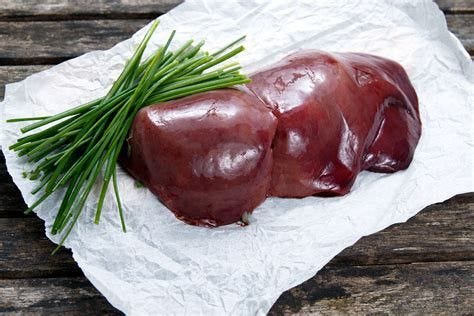Liver and Vitamin A Toxicity
In a recently recorded podcast I was asked my thoughts on a prominent figure in the carnivore community’s agreement with sentiments form…
In a recently recorded podcast I was asked my thoughts on a prominent figure in the carnivore community’s agreement with sentiments form their guest that Vitamin A is toxic and that we should stop eating liver.
I had seen an initial post from Judy Cho (Nutrition with Judy) and my “off the cuff” response while recording was that the post seemed to “stir the pot”; but of course I would listen to the referenced podcast in full before writing any follow up. In fact, I listened to Judy’s podcast with Grant Genereux and followed up on the referenced sources before listening to responses from anyone else (e.g. Brian Sanders, Paul Saladino, etc.)
Let me say ahead of time that I have a tremendous amount of respect for Judy and the work she’s done and what she’s contributed to the space and influence on my own work. I have benefited from and referenced her material(s) many, many times (especially her Carnivore 75 Hard Challenge).
Judy also did write a follow up article (1) here on Medium which paints a slightly different picture where she’s raising awareness that Vitmain A can be toxic and that it may be problematic for some people — a very different impression than I got from the podcast (opinion).
At any rate, my goal isn’t to start a flame war or be divisive — there’s enough infighting in the ancestral health space already. I wanted to investigate these claims myself so that I can give an informed opinion for those who had asked. So, here we go.
The Podcast: Notes I Made
Grant makes a lot of references to supplemented / foods fortified with Vitamin A (which you shouldn’t be eating cereals!)
He does talk about pre-formed (animal) Vitamin A, but at times it’s hard to distinguish which he’s referring to.
Grant references epidemiology over the past 50 years, but there’s not clarification about increases in seed oil consumption or decreases in physical activity or other comorbidities and lifestyle choices.
Grant does specifically mention that Vitamin A toxicity is worsened by bread and soy consumption (again, why are we eating these in the first place?!)
Judy does bring up that there are a lot of other nutrients in liver, which Grant dismisses and says the Vitamin A risk(s) aren’t worth it.
Judy mentions the scale of spreading out a whole organ among an entire tribe (e.g. much smaller does then eating a whole liver by yourself) — important distinction I think.
Grand (and Judy) encourage people to DYOR (do your own research)
Grand explicitly says that he’ “not doing this for (his) health, but to prove a point.” That’s a huge confounding factor and conflict of interest in my opinion. Ancel Keys was trying to “prove a point” too, as was Harvey Kellogg, as are many vegan proponents.
Grant suspects that LDL will go up with Vitamin A consumption (I hadn’t heard this before and needed to look into it more). He doesn’t specifically state that LDL is a problem, but does reference that LDL is a carrier molecule (which is accurate); and so as the cargo (Vitmain A) goes up, so will the delivery trucks (LDL).
Chasing Rabbits and References
The acute and chronic toxic effects of vitamin A (2)
“To control vitamin A deficiency, large therapeutic doses are administered in developing countries to women and children, who often are undernourished.”
“Moreover, appropriate dosing regimens have not been systematically evaluated to ascertain the quantitative improvement in vitamin A status of the women and children who receive these supplements. The known acute and chronic effects of vitamin A toxicity have been reported previously. However, further research is needed to ascertain the areas of the world in which subclinical toxicity exists and to evaluate its effects on overall health and well-being.”
We’ve got some very specific distinctions that need to be made here. We’re talking specifically about supplements and malnourished populations. This may, as is often the case with RDAs / RDIs, based on an unhealthy user bias. That is, the recommendations given are based on supplementing an unhealthy population.
The effect of hypervitaminosis A and other dietary factors on the young pig (3)
Admittedly, I didn’t read all of this study, as it’s 188 pages(!). It is, as the title says, a study in pigs (not humans), but my understanding is that pigs aren’t a bad model for human digestions, so let’s see what we’ve got here:
beta-carotene is used as a supplement (donated by a pharmaceutical company)
Beef liver has about 50,000 IU / 100g serving. The lowest interval tested and showing signs of hypervitaminosis was 200,000 IU / lb of feed; that would be equivalent to eating 1 lb of (beef) liver / day and nothing else.
The lowest referenced sample for hypervitaminosis was at 100,000 IU / lb of feed; still. This means that (if we’re talking about whole foods and not supplements) for every pound of meat you’re eating, 8 oz of that is liver.
The lowest referenced referenced for “claimed depression and weight gain” was 12,000 IU / lb of feed. This is at least a more reasonable ratio of about 2 oz of liver / lb of feed. So, if you’re eating 2 lbs of meat / day you need to be eating 4 oz of liver every single day.
Sudden death via internal hemorrhaging was noted at 400,000 IU / lb of feed which, as we already saw at 100,000 IU / lb and 200,000 IU / lb of food is an unreasonable amount from whole foods.
The point to hammer home here is that the study isn’t referencing total IU ingestion (IU / day); they’re referencing IU / lb of food which is a huge distinction if you’re eating 2–3 lbs of meat / day or — admittedly I did not look into — you, like the pigs, may be eating gross amounts of grains and soy!
Vitamin Sources in Arctic Regions / The Toxic Effect of Polar Bear Liver (4)
“A great part of this book deals with details of limited interest, such as, for instance, the evidence that polar bear liver is toxic only on account of its vitamin A content and not because of associated compounds. It does not deal adequately with the growing literature on hypervitaminosis A in man.”
Polar Bear liver has about 24,000 IU / g (2,400,000 IU / 100g serving) (5). That is almost 50x what is in beef liver at about 500 IU / g.
Vitamin A and LDL (6)
“These data suggest an interaction between vitamin A and cholesterol that is independent of the transport mechanisms for vitamin A in association with chylomicrons (post absorptive) and with RBP.”
It seems there’s some merit to this then, though they note that they only successfully lowered cholesterol in 16 / 48 patients. 1 / 3 seems low in my opinion.
I looked a little further and found that “Plasma levels of vitamin A and its protein vectors (RBP and PA), carotene, total cholesterol and HDL-cholesterol in healthy adults of the female sex”… “Vitamin A plasma levels were shown to be significantly related (P less than 0.01) to RBP and PA, but not to the other parameters examined (carotene, HDL-and total cholesterol).”(7). That doesn’t specifically exclude LDL, but it does seem that process is more complicated than it appears at the surface.
Another study with “metabolically healthy” (not diabetic or on cholesterol or blood pressure medication) women who were obese (8) found that “There was a significant positive correlation (P value = 0.0225) between vitamin A consumption and HDL cholesterol serum levels in obese participants; when vitamin A levels decrease, HDL levels decrease more in female than in male participants.” Now, this was using a food frequency questionnaire which have historically been relatively inaccurate.
Paul Saladino’s Response: and my follow up
Paul made a video response (9) to an influx of questions about Vitamin A toxicity, which I’m sure was spurred by much of the above. On that YouTube video, I did comment myself links to the studies he referenced, some of which I also mentioned above.
Similar to Judy, Paul mentions the ancestral / tribe consistency of spreading out an entire liver throughout the entire tribe to portions of maybe one ounce (or less?) per person, per kill.
Paul mentions inter-individual variability (again, DYOR)
Paul references the polar bear article I cited and says it’s a 100x as rich in Vitamin A as beef liver, but I read that as 50x.
Paul points out, many times, that many of the Vitamin A toxicity studies use supplements, and such supplements are up to 20x more concentrated that naturally occurring forms of Vitamin A (10, 11) — he didn’t reference the first study explicitly, but I found it.
Paul claims there are different rates of excretion vs. reabsorption while Grant claimed the reabsorbed amount of Vitamin A was high (80% I think?). I did find a few references of my own suggesting that “hepatic recylcing may be worsened by various drugs” (12), “kidney function (in dogs) is critical to excrete Vitamin A (which is in high concentrations in renal cells)” (13), and “urinary excretion can be (higher) when other infections are present” (14).
The New England Journal of Medicine noted birth defects associated with Vitamin A supplements (15) and in studies referencing Vitamin A “from food alone” rather than multivitamin supplements, often what’s referenced is (as noted above) “fortified” cereal / grains (16).
Paul points out that there are benefits to Vitamin A (again though, this doesn’t always mean that more is better!) such as strengthening and protecting the intestinal tract (17), and along with iron can be as helpful as hormone treatment for delayed puberty in children (18). In these cases, it’s important to note that the conversion of (plant) Vitamin A (beta-carotene) to a bioavailable for is rather low (19).
Conclusions:
After doing some of my own homework then, what are my conclusions?
I’m still going to eat liver in ancestrally appropriate amounts (maybe 16oz every 1–2 weeks, or about 1 oz / day). I find that my palate naturally selects this pace though. Because I don’t want the liver to spoil in the fridge, typically I will eat 4oz a few days in a row, but then not for week or so after.
Should children still eat liver? Probably. There are a ton of other vitamins in beef liver, but remember that small children and babies aren’t eating as much volume (pounds of food per day) so, if there’s anything to be taken from the pig studies, it’s that that needs scaled appropriately.
Whole food is still superior in every way to supplements.
If we’re going to advocate “ancestral health” we need to be advocating ancestrally appropriate proportions as well. That means a lot of meat, a ton of fat, and a few organs and bones. Remember, there’s only one liver and two kidneys per cow. So, if one is butchered or hunted, the meat lasts several months worth of meals, so it seems reasonable that the organs should too.
Until next time, keep on keepn’ on. Eat meat and fat, play in the sun, and love each other!




